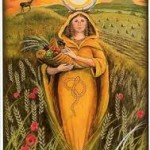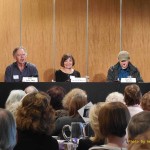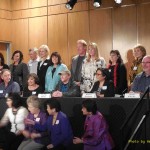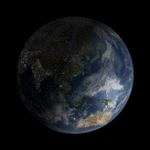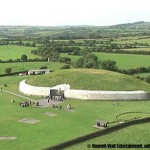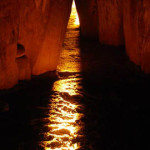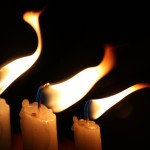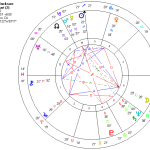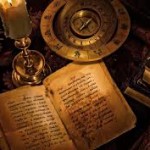 Julia Bonatti, my protagonist in the Zodiac Mysteries, is an astrologer who grew up in North Beach and is often found visiting The Mystic Eye, an occult shop and bookstore owned by her good friend Gale. The Mystic Eye is right on Broadway and just around the corner is perhaps the most famous bookstore in the world — City Lights at 261 Columbus Avenue, a San Francisco icon.
Julia Bonatti, my protagonist in the Zodiac Mysteries, is an astrologer who grew up in North Beach and is often found visiting The Mystic Eye, an occult shop and bookstore owned by her good friend Gale. The Mystic Eye is right on Broadway and just around the corner is perhaps the most famous bookstore in the world — City Lights at 261 Columbus Avenue, a San Francisco icon.
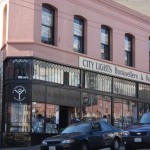 Whenever I’m in North Beach, I always make it a point to visit and explore every creaking wooden floor of books. The first room on the right houses recent additions, history and politics. Climbing to the third floor, you’ll find the poetry section. But my favorite, the mystery section, is one floor down via a narrow wooden stairway. It’s a must see place for booklovers!
Whenever I’m in North Beach, I always make it a point to visit and explore every creaking wooden floor of books. The first room on the right houses recent additions, history and politics. Climbing to the third floor, you’ll find the poetry section. But my favorite, the mystery section, is one floor down via a narrow wooden stairway. It’s a must see place for booklovers!
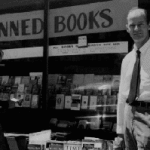 City Lights was founded in 1953 by Lawrence Ferlinghetti and Peter D. Martin. The independent bookstore has always specialized in world literature, the arts and progressive politics. It was the first bookstore in the U.S. to sell only paperbacks. To quote their website, “City Lights is . . . a place where booklovers from across the country and around the world come to browse, read, and just soak in the ambiance of alternative culture’s only “’Literary Landmark.’” The bookstore is still committed to innovative and progressive ideas and resisting the forces of conservatism and censorship. City Lights grew out of the “beat” movement and its legacy of anti-authoritarian politics and insurgent thinking.
City Lights was founded in 1953 by Lawrence Ferlinghetti and Peter D. Martin. The independent bookstore has always specialized in world literature, the arts and progressive politics. It was the first bookstore in the U.S. to sell only paperbacks. To quote their website, “City Lights is . . . a place where booklovers from across the country and around the world come to browse, read, and just soak in the ambiance of alternative culture’s only “’Literary Landmark.’” The bookstore is still committed to innovative and progressive ideas and resisting the forces of conservatism and censorship. City Lights grew out of the “beat” movement and its legacy of anti-authoritarian politics and insurgent thinking.
 A bit of history here ~ the core group of Beats were friends who joined together and became a movement – Jack Kerouac, Allen Ginsberg, Neal Cassady, Gregory Corso, Herbert Huncke, and William S. Burroughs. They met at Columbia in the mid-1940s, then moved west to San Francisco and added Gary Snyder, Lawrence Ferlinghetti, Michael McClure, Philip Whalen, and Lew Welch to their cadre. To quote Allen Ginsberg, “Nobody knows whether we were catalysts or invented something, or just the froth riding on a wave of its own. We were all three, I suppose.”
A bit of history here ~ the core group of Beats were friends who joined together and became a movement – Jack Kerouac, Allen Ginsberg, Neal Cassady, Gregory Corso, Herbert Huncke, and William S. Burroughs. They met at Columbia in the mid-1940s, then moved west to San Francisco and added Gary Snyder, Lawrence Ferlinghetti, Michael McClure, Philip Whalen, and Lew Welch to their cadre. To quote Allen Ginsberg, “Nobody knows whether we were catalysts or invented something, or just the froth riding on a wave of its own. We were all three, I suppose.”
 Beat culture — the rejection of standard narrative values, the spiritual quest, exploration of Western and Eastern religions, experimentation with psychedelic drugs, rejection of materialism, explicit portrayals of human life — has always been entwined with the city of San Francisco. The members of the so-called Beat Generation developed a reputation as bohemian hedonists who celebrated non-conformity and spontaneous creativity. Works such as Allen Ginsberg’s Howl (1956), William S. Burroughs’s Naked Lunch (1959), and Jack Kerouac’s On the Road (1957) are some of the best known examples of Beat literature. These novels were attacked in obscenity trials, although those trials ultimately helped to liberalize publishing within the United States.
Beat culture — the rejection of standard narrative values, the spiritual quest, exploration of Western and Eastern religions, experimentation with psychedelic drugs, rejection of materialism, explicit portrayals of human life — has always been entwined with the city of San Francisco. The members of the so-called Beat Generation developed a reputation as bohemian hedonists who celebrated non-conformity and spontaneous creativity. Works such as Allen Ginsberg’s Howl (1956), William S. Burroughs’s Naked Lunch (1959), and Jack Kerouac’s On the Road (1957) are some of the best known examples of Beat literature. These novels were attacked in obscenity trials, although those trials ultimately helped to liberalize publishing within the United States.
 The Beat Generation unwittingly sired a parody group known as the “beatniks.” The phrase was coined by Herb Caen, a writer for the San Francisco Chronicle, and an icon in his own right, by combining the name of the Russian satellite Sputnik and Beat, implying that the beatniks were far outside of mainstream society and possibly even Communists! The name stuck and became a well known label for the stereotype of the Beat — a man with a goatee and beret, reciting poetry and playing the bongos.
The Beat Generation unwittingly sired a parody group known as the “beatniks.” The phrase was coined by Herb Caen, a writer for the San Francisco Chronicle, and an icon in his own right, by combining the name of the Russian satellite Sputnik and Beat, implying that the beatniks were far outside of mainstream society and possibly even Communists! The name stuck and became a well known label for the stereotype of the Beat — a man with a goatee and beret, reciting poetry and playing the bongos.
In the 1950’s, Vesuvio’s, a bar that’s still going strong in North Beach, hired an artist to sit in their window and paint. The artist was dressed in a full beard, turtleneck, and sandals. By the late 50’s, tourists visiting San Francisco could take bus tours to view the North Beach “beatnik.” I doubt such a character would even raise an eyebrow today on the streets of the city.
 City Lights is a unique San Francisco experience, almost as interesting as the fictional Mystic Eye around the corner. The bookstore is world famous but still retains a casual and intimate charm. Lawrence Ferlinghetti said, “It is as if, the public were being invited, in person and in books, to participate in that ‘great conversation’ between authors of all ages, ancient and modern.”
City Lights is a unique San Francisco experience, almost as interesting as the fictional Mystic Eye around the corner. The bookstore is world famous but still retains a casual and intimate charm. Lawrence Ferlinghetti said, “It is as if, the public were being invited, in person and in books, to participate in that ‘great conversation’ between authors of all ages, ancient and modern.”
If you do visit the city, don’t miss City Lights. You can check out their website for more information. And if you’ve enjoyed Julia’s adventures in San Francisco, try to imagine The Mystic Eye, right around the corner on Broadway.
[This post first appeared at Bibliophile Reviews on July 1, 2017.]

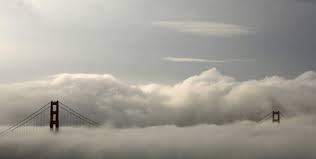



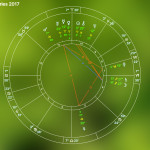 If you look near the top of the chart, you’ll see the symbol for the Sun at exactly 0 degrees and 0 minutes Aries. It looks like a circle with a dot in the middle. The very beginning of the the zodiac. A harbinger of the coming spring.
If you look near the top of the chart, you’ll see the symbol for the Sun at exactly 0 degrees and 0 minutes Aries. It looks like a circle with a dot in the middle. The very beginning of the the zodiac. A harbinger of the coming spring.



